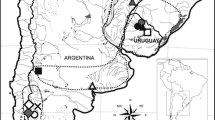Abstract
Flow cytometry (flow microfluorimetry) provides a quick means for analysis of ploidy in planarians. Nuclei from homogenized tissues of the freshwater planarian Dugesia japonica japonica Ichikawa et Kawakatsu were stained with propidium iodide and measured with an argon-laser flow cytometer to produce histograms of DNA content. Tissues from sexually mature individuals produced histograms with a 1n (haploid) peak but no 3n peak (triploid peak), whereas those from asexual individuals showed a 2n peak or a 3n peak or both, but no 1n peak. Thus, the 1n peak distinguished sexual individuals. Mixoploid individuals, i.e., mosaics with both diploid and triploid tissues, were identified by the presence of both a 2n peak and a 3n peak. The ratios of the heights of the 2n and 3n peaks from tissues in different parts of a single mixoploid individual were similar, suggesting that the diploid and triploid cells are homogeneously distributed.
Similar content being viewed by others
References
Benazzi, M. & G. Benazzi-Lentati, 1976. Platyhelminthes. In B. John (ed) Animal cytogenetics, Vol. 1. Gebrüder Borntraeger, Berlin, Stuttgart: 1–182.
Fried, J., A. G. Perez & B. D. Clarkson, 1978. Rapid hypotonic method flow cytofluorometry of monolayer cell cultures. J. Histochem. Cytochem. 26: 921–933.
Herlan, G. W., A. Eckert, W. Kaffenberger & F. Wunderlich, 1979. Isolation and characterization of an RNA-containing nuclear matrix from Tetrahymena macronuclei. Biochemistry 18: 1782–1788.
Hyman, L. H., 1951. The invertebrates. II. Platyhelminthes and Rhynchocoela. The acoelomate Bilateria. McGraw-Hill, New York, 550 pp.
Krishan, A., 1975. Rapid flow cytofluorometric analysis of mammalian cell cycle by propidium iodide staining. J. Cell Biol. 66: 188–193.
Oki, I., S. Tamura, T. Yomayoshi & M. Kawakatsu, 1980. Karyological and taxonomic studies of Dugesia japonica Ichikawa et Kawakatsu in the Far East. Occ. Publ. Biol. Lab. Fuji Women's College, Sapporo (Hokkaid), Japan (2): 1–23.
Oki, I., S. Tamura, T. Yomayoshi & M. Kawakatsu, 1981. Karyological and taxonomic studies of Dugesia japonica Ichikawa et Kawakatsu in the Far East. Hydrobiologia 84: 53–58.
Tamura, S., I. Oki & M. Kawakatsu, 1988. Karyological and taxonomic studies of Dugesia japonica from the Southwest Islands of Japan. Fortschr. Zool. 36: 123–128.
Ribas, M., M. Pala, R. A. Vacca, M. Riutort & J. Baguna, 1988. Taxonomic status of the western Mediterranean asexual populations of the Dugesia (D) gonocephala group. Morphological, karyological and biochemical data. Fortschr. Zool. 36: 129–138.
Taylor, I. W., 1980. A rapid single step staining technique for DNA analysis by flow microfluorimetry. J. Histochem. Cytochem. 28: 1021–1024.
Author information
Authors and Affiliations
Rights and permissions
About this article
Cite this article
Hoshino, K., Ohnishi, K., Yoshida, W. et al. Analysis of ploidy in a planarian by flow cytometry. Hydrobiologia 227, 175–178 (1991). https://doi.org/10.1007/BF00027599
Issue Date:
DOI: https://doi.org/10.1007/BF00027599




